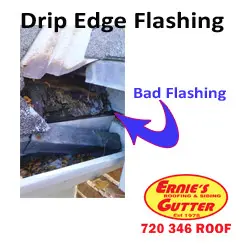Importance of Drip Edge Flashing for Roof Protection
Why Installing a Drip Edge is Essential for Your Roof | Ernie’s Roofing Denver”
meta-description: “Learn why installing a drip edge is crucial for protecting your home from water damage. Expert roofing tips from Ernie’s Roofing in Denver, CO. Call 720-346-ROOF today!”
Why Installing a Drip Edge is Essential for Your Roof
Protecting Your Home with Proper Roof Drainage
Water damage is one of the most common issues homeowners face, often caused by improper roof drainage. One simple yet crucial component in protecting your home is the drip edge—a metal flashing installed at the edges of your roof. At Ernie’s Roofing & Gutter, we’ve been serving Denver, CO, since 1978, ensuring roofs are built to last. If your roof lacks a drip edge, you could be at risk for costly water damage.
What is a Drip Edge?
A drip edge is a metal strip installed along the roof’s edges to direct water into the eaves trough (gutter) instead of allowing it to run down the fascia or behind the gutter. This prevents issues such as rot, ice buildup, and foundation damage.
Why is a Drip Edge Important?
1. Prevents Water Damage
Without a drip edge, water can seep between the fascia and eaves trough, leading to potential structural damage, slippery sidewalks, and hazardous ice buildup in colder months.
2. Protects Fascia and Soffits
When water runs behind the gutters, it can cause rotting of the fascia and soffits, leading to expensive repairs. A drip edge ensures water is properly guided away from the roof’s edge.
3. Enhances Roof Longevity
A properly installed drip edge prevents shingle deterioration and underlayment damage by directing water away from the roof edge.
4. Essential for Ice Dam Prevention
In Denver’s cold climate, ice dams form when water freezes at the roof’s edge. A drip edge helps mitigate this by ensuring proper drainage, reducing the risk of dangerous ice buildup.
5. Required by Building Codes
Many local building codes now mandate the installation of a drip edge for all new roof installations to ensure proper water management and prevent structural damage.
How to Install a Drip Edge on an Existing Roof
If your roof was installed without a drip edge, you can retrofit one by following these steps:
1. Gather Your Tools
Pry bar
Roofing nails
Hammer
Putty knife
Drip edge flashing
Roofing tar
2. Lift the Shingles Carefully
Use a pry bar to gently lift the underlayment, starter strip, and shingles near the roof’s edge. Be careful not to damage them.
3. Slide in the Drip Edge
Position the drip edge underneath the shingles, ensuring that it extends slightly over the gutter for proper water runoff.
4. Secure with Nails
Nail the drip edge through both the starter row and the metal flashing, keeping nails a few inches from the shingle edge.
5. Apply Roofing Tar for Sealing
To prevent wind from lifting the shingles, apply roofing tar under the top row of shingles and press them down.
6. Let Heat Bond Everything Together
Over time, the summer heat will help bond the shingles and drip edge securely, ensuring a long-lasting, waterproof seal.
When Should You Install a Drip Edge?
Ideally, a drip edge should be installed during roof replacement. However, if your roofers skipped this crucial step, you can retrofit it at any time. The best weather conditions for installation are in the spring or fall, when temperatures are between 50-60°F (10-15°C) to avoid shingle damage.
Why Choose Ernie’s Roofing & Gutter?
Since 1978, Ernie’s Roofing & Gutter has been the trusted name in Denver, CO, for quality roofing solutions. We ensure proper drip edge installation to protect your home from costly water damage.
Don’t let improper roof drainage ruin your home! Contact us today for a free inspection and get the right roofing solutions from Denver’s most experienced contractors.
FAQs About Drip Edges
1. Can I install a drip edge myself?
Yes, but proper installation requires careful handling of shingles and securing the metal flashing correctly. If unsure, it’s best to hire a professional.
2. How much does it cost to install a drip edge?
Costs vary depending on roof size and material. Contact Ernie’s Roofing & Gutter for an accurate estimate.
3. What happens if my roof doesn’t have a drip edge?
Without a drip edge, water can cause fascia rot, foundation erosion, and dangerous ice buildup on walkways.
4. Can a drip edge be added after the roof is installed?
Yes, a retrofit drip edge can be carefully installed by lifting shingles and sliding the metal underneath.
5. What type of drip edge is best?
Aluminum and galvanized steel are the most durable and cost-effective choices.
6. Is a drip edge required by building codes?
In many areas, yes. Always check local regulations or consult with a professional.
7. How long does a drip edge last?
When properly installed, a drip edge can last as long as your roof, typically 20-30 years.
8. Will a drip edge stop ice dams?
While it helps with water runoff, other preventive measures like roof insulation and proper ventilation are also necessary.
9. Can wind lift a drip edge?
Not if properly secured with roofing nails and sealed with roofing tar.
10. What color should a drip edge be?
Most homeowners match the drip edge color with their roof or gutters for aesthetic appeal.
Get a Professional Drip Edge Installation Today!
Protect your home with a professionally installed drip edge. Call Ernie’s Roofing & Gutter at 720-346-ROOF for a free inspection and let our experts take care of your roofing needs!
🌐 https://erniesgutter.com/
What is Metal Flashing?
Metal flashing is a critical component in roofing systems, designed to direct water away from vulnerable areas of the roof. It is typically made from materials like aluminum, copper, or galvanized steel to prevent leaks and extend the lifespan of a roof.
Types of Metal Flashing and Their Uses
-
Drip Edge Flashing – Installed along the roof’s edges to direct water into the gutters and prevent water damage to fascia and soffits.
-
Step Flashing – Used where a roof meets a vertical wall, ensuring that water is diverted away from the intersection.
-
Valley Flashing – Installed in roof valleys to channel water safely off the roof and prevent pooling.
-
Chimney Flashing – Placed around chimneys to prevent water from seeping into the roof and structure.
-
Vent Pipe Flashing – Seals around vent pipes and other protrusions to prevent leaks.
-
Ridge Cap Flashing – Covers the ridge of the roof to prevent water penetration.
-
Counter Flashing – Works in conjunction with step flashing, often embedded in brick or stucco walls for added waterproofing.
-
Base Flashing – Installed at the base of walls, chimneys, or skylights to work with counter flashing and keep water out.
-
Apron Flashing – Used at roof penetrations such as dormers to direct water away from joints.
-
Continuous Flashing (Z-Flashing) – Provides long-term protection along roof edges and parapet walls.
Benefits of Metal Flashing
-
Prevents Water Damage – Directs water away from critical areas to avoid leaks.
-
Extends Roof Lifespan – Protects the roof from premature deterioration.
-
Enhances Structural Integrity – Reduces the risk of wood rot and mold formation.
-
Resists Corrosion – Made from durable materials like copper and aluminum.
-
Improves Aesthetic Appeal – Provides a seamless, finished look to a roofing system.
10 Frequently Asked Questions (FAQs) About Metal Flashing
1. What is the best type of metal flashing for my roof?
The best type depends on your roof material and climate. Aluminum is lightweight and resistant to corrosion, while copper is durable and aesthetically appealing.
2. Can I install metal flashing myself?
While DIY installation is possible, professional installation ensures a watertight seal and proper placement.
3. How often should metal flashing be replaced?
Flashing can last 20+ years, but regular inspections can help identify signs of wear and tear.
4. What are the signs that my flashing needs repair or replacement?
Rust, loose or missing sections, water leaks, and visible gaps are common signs of flashing failure.
5. Can metal flashing be painted?
Yes, metal flashing can be painted with a high-quality exterior metal paint to match your roof’s appearance.
6. Is metal flashing required by building codes?
Yes, most building codes require flashing in critical roof areas to prevent water intrusion.
7. Does metal flashing work with all roofing materials?
Yes, metal flashing is compatible with asphalt shingles, metal roofs, tile, and more.
8. Can damaged flashing cause leaks?
Yes, improperly installed or deteriorated flashing is one of the leading causes of roof leaks.
9. How much does metal flashing installation cost?
Costs vary depending on material and labor, but typically range from $200 to $500 for professional installation.
10. Does flashing require maintenance?
Yes, periodic inspections and resealing with roofing tar or caulk can prolong its lifespan.
📍 Address: 1195 W Custer Pl, Denver, CO 80223
📞Call Us: 720-346-ROOF
🌐 Website: https://erniesroofing.com/
OUR SERVICES
Your Neighborhood Roofing Contractor
Get more information concerning our service, do not wait to call us at 720 346 ROOF today. We’ll be more than happy to schedule a meeting with you.
Residential Roofing Contractor
Ernie’s Roofing specialize in residential roofing in Denver and have a team of experienced professional Roofers available to help you get the job done right The First Time. From minor repairs and maintenance to full–scale roof replacements,

Commercial Roofing
We construct, repair, as well as maintain Commercial Roofing systems for services both large and also small, creating personalized services that conserve our client’s time, cash, and also power. Call us at 720 346 ROOF and book a consultation today.

Hail Damage
Their knowledgeable staff is ready to help you assess the damage caused by storms and provide you with a comprehensive repair evaluation & plan. We specialize in all types of roof damage, including hail, wind, and even lightning strikes. Hail Claim Help

INSURANCE CLAIMS HELP
Our team of experienced insurance claim specialists will work with you to ensure that the insurance claim process is as stress-free as possible. We will work with your insurance company to provide all necessary documentation and estimates to ensure that your claim is processed quickly and correctly.

Wind Damage
When it comes to roof damage, it can be difficult to determine whether the damage was caused by hail or wind. While both types of damage can cause similar symptoms, they have different causes and require different repair methods.
What’s New on The Blog
Find a Roof Leak Like a Pro
Roof LeakLatest News & Resources When you need a roof contractor you can rely on the team of experts at Ernie's Roofing. We specialize in a wide range of services from new construction, maintenance, and repairs for your home or business.How to Find a Roof Leak...
Why Roof Replacement vs Roof Repair
Roof Replacement vs Roof RepairLatest News & Resources When you need a roof contractor you can rely on the team of experts at Ernie's Roofing. We specialize in a wide range of services from new construction, maintenance, and repairs for your home or business.Why...
Valley Return Roof Flashing Repair
Valley Return Roof Flashing RepairLatest News & Resources When you need a roof contractor you can rely on the team of experts at Ernie's Roofing. We specialize in a wide range of services from new construction, maintenance, and repairs for your home or...
#1 Rated Roofing Contrator In Denver
Craftsmanship That Stands Like a House
Let’s Get Your Project on the Right Track

Let’s Get Started


